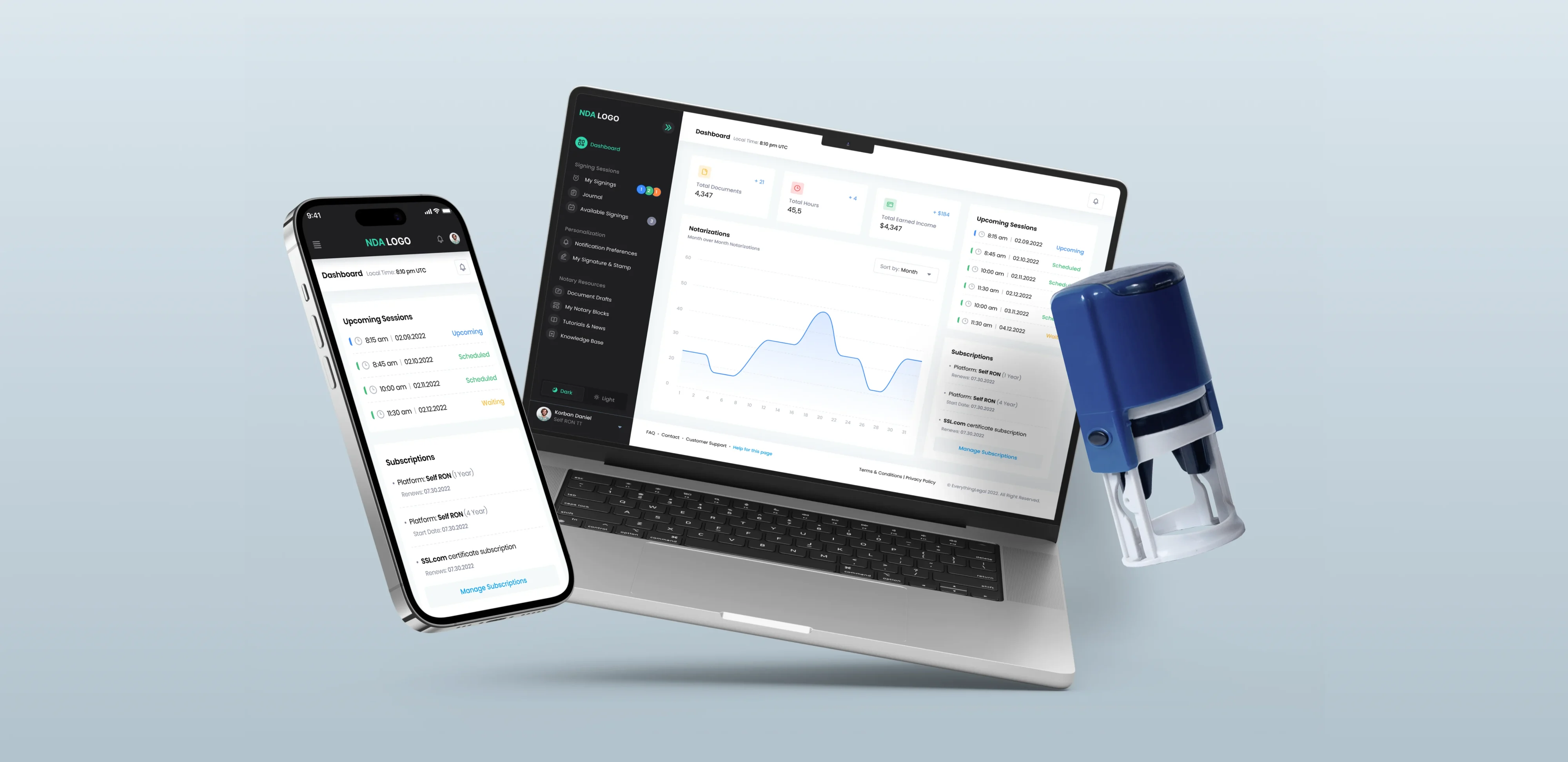
Highlights
- Cutting-Edge Notary Service Redesigned: delivered an Admin Panel with different user roles from scratch, developed storage functionality, successfully dealt with legacy code, and integrated 13+ third-party services.
- Highly Secure Web Application: implemented identity verification, digitally authenticated signatures, and digitally embedded fingerprints to maximize data protection.
- Large Scope of Work: completed 1990+ tasks, some of them already become features in production that users can leverage, and some of them are being continuously tested.
Client
The client is a Legal Tech startup looking to redesign a previously built mission-critical Web-based application to offer more functionality and expand the business reach of the remote notary service.
Product
The product is a web service that allows individuals and companies of various sizes to receive notary assistance online. The service provides legal experts who are suitable for each specific case.
The service allows users to:
- Register the different types of users.
- Request and schedule sessions.
- Have multi-customer sessions.
- Review and finalize customer documents.
- Communicate via video chat during signing sessions.
- Set up user signature and stamp (the last is for notaries only).
- Have pre-session checks for customers.
- Manipulate with unfinished documents.
- Download signed documents.
- Collect a session payment.
- Get auto emails/SMS notifications.
Goals and objectives
- Redesign the Legacy Web Application:
Develop a new application based on the existing solution and introduce more features that would help the platform’s users receive the notary services online on an entirely new level.
- Provide More Scalability and Functionality:
Improve the solution from the technical perspective, allowing the client to build a stronger brand image, attract investors, and cover more areas with the notary services.
Project challenge
- Lack of Project Documentation: conduct a thorough code review and document the existing codebase, creating comprehensive documentation covering architecture, data flow, API usage, and any other relevant information.
- Rewriting Parts of a Legacy Code: identify critical components that need rewriting and implement unit tests to ensure that the rewritten code works the same way as the legacy code.
- The Integration of Third-party Services: create a clear plan for integration, including error handling, authentication, and data synchronization.
- Developing Admin Panel from Scratch Within a Strict Deadline: adopt a Kanban development methodology, breaking down the project into smaller, manageable tasks and prioritizing features based on their importance.
- Complete Redesign of Website and Admin Panel UI: create prototypes for feedback, conduct usability testing, and iterate based on user responses.
- Hiring Additional Specialists: since the customer’s legacy solution was built with PHP and Angular, we also had to recruit additional PHP and Angular developers with relevant legacy system modernization experience.
Solution
To implement the project, we assembled a team comprising a Project Manager, 4 Full-Stack PHP Developers, an Angular Developer, a Quality Assurance Engineer, and a UI/UX Designer.
Despite we got started with having no project documentation, we managed to prepare a 400+ page document that the Project Manager updated ongoingly. Having all the processes clearly documented helped us a lot since the project eventually became much bigger than planned initially.
During the initial iteration of the project, we worked on redesigning a legacy website. Sometimes our team was forced to rewrite some modules from scratch. The reason was that these modules from the older version of the website no longer suited the new business demands of the client or didn’t match the modern technological standards.
We had to work with and customize 13 third-party services the platform is integrated with to make it better matched with current customer’s demands. Some of them were unfamiliar to our developers, but our experts managed to learn new software fast and complete the required tasks.
As the direction and the scope of the project changed, we were asked to build an Admin Panel from scratch. This Admin Panel, which is a CMS, needed to have multiple roles with particular permissions. We successfully created an Admin Panel within a very strict deadline.
When the roles and permissions functionality was complete, we were tasked to create a file manager to store documents in an Admin Panel. As a result, we created a zip service for the conversion and storage of archives, which became the first step to implementing a microservice architecture.
The final phase of the project included the second redesign iteration. Our designer worked on it for 5 months and after that, we implemented the new design and changed the UI across the website and Admin Panel.
-
PHP
-
Laravel
-
JavaScript
-
Angular.js
-
Vue.js
-
MySQL


Our results
We have been involved since the early MVP stage and helped to build a fully functioning product that is currently in an active marketing phase.
- Business Reach Expansion to 20 US States: our involvement helped the client to extend its service geography to more US states, as we made all state-specific requirements supported by the platform.
- Agile Product Development: successfully delivered custom software development and design services during all iterations of the project, staying adaptive to project scope changes and growing business demands.
- Legacy-to-Cloud Smooth Migration: delivered a 100% Cloud-based solution with enhanced UX on both desktop and mobile that reduces paperwork, provides document preparation tools, and saves time on legal processes for the users.
Highlights Client FreeForm Agency focuses on Branding, Consumer Engagement, online communities, Public Relations, and Social Media Management. Product RabbitCards...
Explore Case